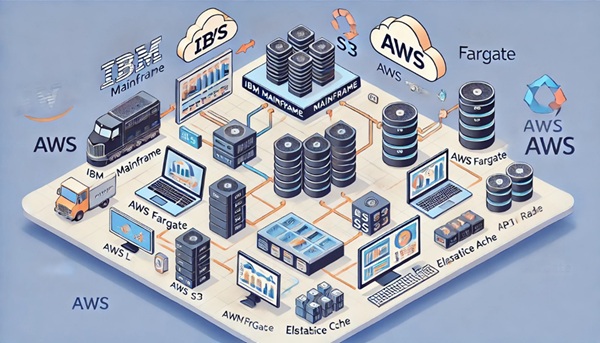Case Study: Modernizing a Legacy IBM Mainframe-Based Data Processing System into a Scalable Cloud-Native Architecture
Overview
ByteCraft Labs presents a case study on modernizing a legacy IBM Mainframe-based data processing system into a scalable, cloud-native architecture on AWS. Our team has deep expertise in executing such transformations, leveraging best practices in data migration, microservices, and cloud computing.
This case study explores the end-to-end migration strategy, focusing on Raw Load, Delta Load, and Incremental Load, ensuring efficient data migration and real-time processing while maintaining business continuity.
Challenges with the Legacy IBM Mainframe System
The existing system processed and managed large volumes of data. However, the legacy mainframe architecture presented several challenges :
- High Operational Costs: Maintaining and upgrading mainframe infrastructure was expensive.
- Limited Scalability: The batch-oriented processing model lacked real-time capabilities.
- Complex Data Handling: Extracting, transforming, and loading (ETL) processes were slow.
- Lack of Modern Interfaces: Outdated interfaces made it difficult for users to interact with the system.
Solution: A full-stack transformation using AWS, microservices APIs, and a modern Angular frontend.
Solution Architecture Overview
The new cloud-native architecture was designed using the following components:
- AWS S3: Centralized storage for raw and processed data.
- AWS Lambda: Data processing automation.
- AWS Fargate (Python Services): Real-time API execution for data validation and ingestion.
- Amazon RDS (Oracle & PostgreSQL): Persistent storage for structured data.
- ElastiCache (Redis): Fast retrieval of real-time data.
- Microservices API (.NET Core Web API): RESTful APIs to expose data to applications.
- Angular Client: Interactive UI for data visualization and management.
Data Migration & Processing Strategy
To ensure smooth data migration while keeping the system operational, the approach was based on a three-stage loading strategy:
1. Raw Load (Initial Full Data Load)
- Purpose: Migrating historical data from IBM Mainframe to AWS S3.
- Process: Raw data files were extracted and compressed (ZIP format). Files were securely transferred to AWS S3 via APIs. A sanity check validated the files before conversion to structured format. The Converted CSV data was stored in Amazon RDS (Oracle/PostgreSQL).
- Outcome: The entire historical dataset was ingested into the cloud while maintaining referential integrity.
2. Delta Load (Change Data Capture)
- Purpose: Capturing periodic updates and modified records.
- Process: The system monitored file changes using AWS Lambda and processed only the modified records. The changes were compared against the existing dataset by means of a cloud-diff mechanism, and only the modified records were subsequently transformed and loaded into the RDS instance.The cloud-diff mechanism compared the changes against the existing dataset. The system then transformed and loaded only the modified records into the RDS instance..
- Outcome: Efficient synchronization between legacy mainframe data and the AWS database.
3. Incremental Load (Real-Time Data Ingestion)
- Purpose: Enabling real-time data ingestion for newly generated records.
- Process: TThe mainframe system continued generating new records and streaming them into AWS S3. AWS Fargate (Python) processed these new records, transforming them into the required format. The API layer ingested these transformed records into Amazon RDS and Redis.
- Outcome: Real-time synchronization, enabling instant analytics and decision-making.
Deployment & API Strategy
- Containerized Services: AWS Fargate hosted Python-based processing services.
- API Gateway & Microservices: The team built APIs using .NET Core Web API to expose data to frontend applications.
- Role-Based Access Control (RBAC): Secure access to APIs, ensuring data privacy.
- Cloudflare Integration: Enhanced performance and security for the Angular frontend.
Frontend Application: Angular-Based Thin Client
The team developed the frontend using Angular, providing:
- Real-time dashboards for monitoring activities.
- Data visualization using charts and graphs.
- Interactive query system for on-demand data retrieval.
- Authentication & Role Management integrated via AWS Cognito.
Key Benefits Achieved
80% Cost Reduction: Moving from a mainframe to AWS significantly lowered infrastructure costs.
Real-Time Data Access: API-driven incremental loads enabled instant access to updated data.
High Scalability: AWS auto-scaling ensured system reliability across multiple regions.
Enhanced Security: IAM-based access control and AWS Shield protection.
Modern UI/UX: The Angular client improved usability and data interaction.
Conclusion
This case study demonstrates how a legacy IBM Mainframe system can transform into a modern AWS cloud-native architecture using Raw Load, Delta Load, and Incremental Load methodologies. The API-driven approach coupled with a thin Angular client enabled real-time, scalable, and cost-effective operations.
This transformation has not only future-proofed operations but has also positioned organizations to leverage advanced analytics and AI-driven insights in the future.
#CloudTransformation #LegacyModernization #MainframeMigration #AWS #Microservices #DataEngineering #DigitalTransformation #Scalability #CloudComputing #DataProcessing #EnterpriseArchitecture #Serverless #CloudSecurity #FutureOfWork
